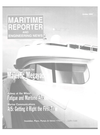
Page 26: of Maritime Reporter Magazine (October 2004)
The Marine Communications Edition
Read this page in Pdf, Flash or Html5 edition of October 2004 Maritime Reporter Magazine
Marine Communications been even better since the radar did not have any problem to see 60 NM but the
AIS faded at that distance. It should have been the opposite if there was a clear requirement to put the AIS antenna as high as the radar. Also to know where the GPS antennas for the AIS are placed is important.
Equipment Placing
The AIS Display equipment needs to be at the conning position if no other display system has been certified as its display system. Also where you put your
AIS is for environmental reasons and to reduce the installation costs are vital factors to consider in the process.
Pov/er Supply
The AIS has to, according to IMO instillation guidelines, be connected to an emergency power source. IMO per- formance standard on AIS states "The
AIS and associated sensors should be powered from the ship's main source of electrical energy. In addition, it should 0MTM
MARITIME TElECOMMIINICflTlONS NETWORK
The
LEADER "ALWAYS ON" VSAT
COMMUNICATIONS SOLUTIONS I -
MTN's "Always On" VSAT technology offers exceptional global connectivity including solutions for voice, data, Internet, and compressed video. Additionally MTN offers a wide array of services including: Digital Seas - our turn -key Internet Cafe,
OceanNews - daily newspaper service, Prepaid Calling Cards,
Live Broadcast Services and Shore to Ship Calling.
Optimize Your Communications Systems with MTN
Toll Free: 877.464.4MTN (4686) • 954.538.4000 • Fax 954.431.4077 [email protected] • www.mtnsat.com
Circle 229 on Reader Service Card be possible to operate the AIS and asso- ciated sensors from an alternative source of electrical energy." But what does it really mean? There was an additional recommendation on this made by COM-
SAR 8 in February.
Interfacing Other Equipment
This is one of the most problematic issues when installing the AIS onboard.
It could be interesting to know what the
IMO performance standard says on the issue: "To enable a user to access, select and display the information on a sepa- rate system, the AIS should be provided with an interface conforming to an appropriate international marine inter- face standard. • a means of processing data from an electronic position-fixing system which provides a resolution of one ten thou- sandth of a minute of arc and uses the
WGS-84 datum.; • a means to automatically input data from other sensors meeting the provi- sions as specified in paragraph 6.2;"
Cabling
Depending on the IMO installation guidelines, your class, the equipment manufacturer and how the IEC standard is read not all cable types are allowed to be used for installation. This could have very costly effects if you need to do it all over again, since cabling is one of the more expensive parts of the installation.
Reliability
How reliable are the different manu- facturer's products not only when it comes to failure rate but also when it comes to performing according to the standards? IALA did as late as during autumn 2003 issue concerns about how
AIS equipment operated in various ways when transmitting or responding to mainly Safety and Broadcast Binary
Messages. I have before expressed con- cerns about the testing of AIS and I stress the importance of a unified test process since the AIS system is a co- operative communication system depending on the same behavior of all participants in the network.
Maintenance and Support
The quality and cost for your mainte- nance and support will be different from manufacturer to manufacturer. Make sure that check the capability of your supplier before you fit your ship, other- wise you will end up with extra costs that mount fast.
Approval Procedures
The approval of your equipment and installation will be according to your class and flag state procedures and these could vary, but be aware that certain
SHIP SECURITY ALERT
Two solutions from SAILOR - your choice! ^SAILOR
When safety counts
Circle 212 on Reader Service Card • Meet the IMO requirements for
SSAS • Additional communication services • Only standard subscription cost - no additional fees for SSAS functionality
SAILOR Iridium SSAS.
Based on the Iridium
Satellite Network.
Visit www.sailor.dk • SSAS information and brochures • World-wide Distribution and
Service Network
SAILOR H3000M SSA Mini-C. Based on the Inmarsat Satellite Network. 26 Maritime Reporter & Engineering News

 25
25

 27
27
